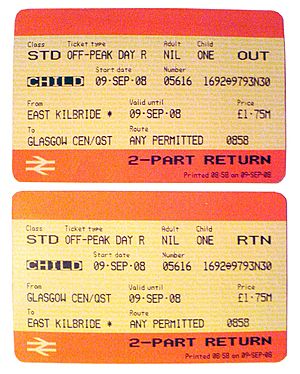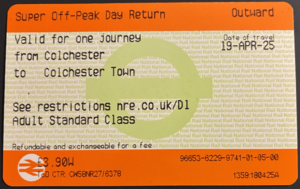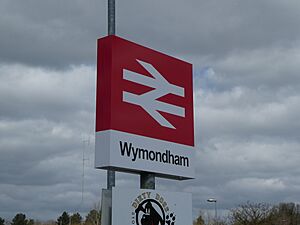National Rail facts for kids
| Type | Public transport |
|---|---|
| Owner | Rail Delivery Group |
| Country | United Kingdom |
| Introduced | 1999 |
| Related brands | |
| Markets | United Kingdom |
National Rail (often called NR) is the main name used for passenger train services in England, Scotland, and Wales. It's like a big brand that brings together many different train companies. These companies run the trains that used to be operated by British Rail before 1999.
National Rail services share a common system for tickets. This means you can usually use one ticket to travel on different train companies' services. The official website, nationalrail.co.uk, helps you plan journeys and buy tickets.
Contents
National Rail and Network Rail: What's the Difference?


It's easy to mix up National Rail and Network Rail, but they are different!
- National Rail is the brand name for passenger train services. It helps make ticketing and information consistent for people traveling.
- Network Rail is the company that owns and manages most of the railway tracks, stations, and signals in Great Britain. Think of them as the people who look after the railway lines themselves.
The National Rail website is managed by the Rail Delivery Group. This group works for the train companies to make train travel simpler and better for everyone. Most passenger trains run on tracks owned by Network Rail. However, some lines also carry freight trains, and a few passenger services run on tracks not owned by Network Rail, like parts of London Underground.
Train Companies (TOCs)
The trains you ride on are run by different companies called Train Operating Companies (TOCs). In the past, these companies had special agreements with the government called "franchises." Now, they mostly have "operating contracts."
The Rail Delivery Group represents these train companies. They provide important services like the National Rail Enquiries website. They also help manage how ticket money is shared between the different companies.
The Famous Double Arrow Symbol
National Rail uses a very famous symbol: the double arrow. This symbol was first designed for British Rail in 1964. You can see it on train tickets, the National Rail website, and at railway stations. It's a special sign that means "railway station" on road signs across Great Britain.
The double arrow symbol helps people recognize train services easily. Even though different train companies have their own designs for their trains and stations, the double arrow keeps a common look for the whole railway network.
Other Train Services in Great Britain
Not all train or tram systems in Great Britain are part of National Rail. Many big cities have their own local transport systems, such as:
- The London Underground (the "Tube")
- Docklands Light Railway in London
- Tram systems like Manchester Metrolink and Sheffield Supertram
- The Glasgow Subway
- The Tyne and Wear Metro
However, some local networks, like Merseyrail in Liverpool, are part of the National Rail system.
The London Overground and the Elizabeth line are a bit special. They are run by Transport for London (TfL), but they are also considered part of National Rail. This means you can use National Rail tickets on them. But, they also have their own fare system, similar to the London Underground.
Trains like Eurostar, which travels to Europe, and Northern Ireland Railways are not part of the National Rail network. There are also many smaller, privately owned or heritage railways that operate for fun or history, not as regular public transport.
Tickets and Fares
National Rail services have a common way of selling tickets, which makes it easy to travel. You can buy tickets between almost any two stations on the network from any ticket office. Most tickets can be used on any train company's service that travels on your chosen route.
Here are some common types of tickets:
- Advance tickets: These are usually cheaper if you book them early for a specific train and time.
- Off-peak tickets: These are for traveling during quieter times, like outside of rush hour.
- Anytime tickets: These can be used on any train at any time.
- Season tickets: These allow unlimited travel between two stations for a set period, like a week, month, or year.
- Rover/Ranger tickets: These let you travel as much as you want within a certain area or on specific train lines for a set number of days.
In Greater London, you can use an Oyster card or a contactless debit/credit card to pay for National Rail journeys.
If you get on a train without a valid ticket at a station where you could have bought one, you might have to pay a higher fare or even a penalty fare.
Timetables and Information
You can find timetables for individual train companies at staffed stations. The full, official printed timetable stopped being published in 2007. Now, you can find the complete timetable as a digital file on the Network Rail website. However, it's often easier to get timetables directly from the websites of the train companies you plan to use.
National Rail Enquiries Website
The National Rail website (nationalrail.co.uk) is a very important tool for train travelers. It helps millions of people plan their journeys every day. It's known for being Britain's largest and most accurate travel information website.
The website lets you:
- Plan your journey from one station to another.
- Find out how much tickets cost.
- See live updates on train departures and arrivals.
When you choose your tickets on the National Rail website, it sends you to the train company's website to buy them. This way, you usually don't pay extra booking fees.
There's also a National Rail mobile app for phones, which has the same features as the website. In 2020, a service called "Alert Me" was launched, which sent real-time updates about train delays or crowding through messaging apps. This service was updated in 2021 but was closed in June 2023, leaving a simpler text message service.
In 2021, the nationalrail.co.uk website joined "The Green Travel Pledge." This is a commitment to help reduce carbon emissions from transport in the UK by 2050.
The website got a big update in June 2023, with a new, modern look. In early 2024, the old journey planner was replaced with a new version. This planner uses a special data system called Darwin, which provides real-time information about train delays, changes, and cancellations. Darwin has been helping power train information for over 20 years!
See also
 In Spanish: National Rail para niños
In Spanish: National Rail para niños
- Great British Railways
- Rail Accident Investigation Branch
- Rail transport in the United Kingdom
- Railcard



